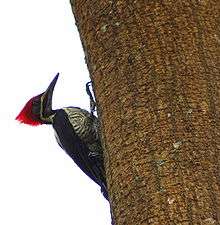Lineated woodpecker
| Lineated woodpecker | |
|---|---|
.jpg) | |
| Scientific classification | |
| Kingdom: | Animalia |
| Phylum: | Chordata |
| Class: | Aves |
| Order: | Piciformes |
| Family: | Picidae |
| Genus: | Dryocopus |
| Species: | D. lineatus |
| Binomial name | |
| Dryocopus lineatus (Linnaeus, 1766) | |
| Subspecies | |
|
5 ssp., see text | |
| Synonyms | |
|
Hylatomus lineatus | |
The lineated woodpecker (Dryocopus lineatus) is a very large woodpecker which is a resident breeding bird from Mexico south to northern Argentina and on Trinidad.
Description

The lineated woodpecker is 31.5 to 36 cm (12.4 to 14.2 in) long. It resembles the closely related pileated woodpecker (Dryocopus pileatus) of United States and Canada.
Adults are mainly black above, with a red crest and whitish lines from the base of the bill, down the neck and shoulders (though individuals from the south-eastern part of its range commonly lack the line on the shoulders). The underparts are whitish, heavily barred with black. They show white on the wings in flight. Adult males have a red line from the bill to the throat (malar) and a red forehead. In adult females, these plumage features are black. The bill is typically black in both sexes, though pale-billed individuals regularly are seen.
The call of this widespread but wary bird is a loud, ringing wic-wic-wic. Both sexes drum.
In most of its range, it is most likely confused with the crimson-crested woodpecker (Campephilus melanoleucos), which is similar in plumage and size. In the female of that species, the light face line is far broader, and the white shoulder lines meet on the back lower back (forming a "V"). The male crimson-crested woodpecker is quite different with its almost entirely red head.
Subspecies
- D. l. scapularis – (Vigors, 1829): found in western Mexico (Sonora south to Guerrero). The white stripe on the sides of the face is reduced or lacking; also smaller than similis and nominate lineatus. Bill pale, pale horn, dull white, or bluish white.
- D. l. similis – (Lesson, 1847): found in eastern and southern Mexico south to northwestern Costa Rica. Bill pale, pale horn, dull white, or bluish white. Underparts buffy. Body mass is 136–181 g (4.8–6.4 oz).
- D. l. lineatus – (Linnaeus, 1766): nominate, found in eastern and southern Costa Rica south to western Colombia and east to Trinidad, the Guianas and northeastern and eastern Brazil (Maranhão, Bahia), and south to eastern Peru, northern Paraguay and south central Brazil (São Paulo). Bill dark. Body mass is 186–228 g (6.6–8.0 oz).
- D. l. fuscipennis – (P. L. Sclater, 1860): found in western Ecuador and northwestern Peru. Bill dark. Smaller than nominate lineatus. Plumage browner, less black.
- D. l. erythrops – (Valenciennes, 1826): found in eastern Paraguay, northern and northeastern Argentina and southeastern Brazil. Bill dark. Larger than nominate. White scapular lines often reduced; generally the scapular lines are absent in southern populations, but the "proportion of individuals with scapular lines increases towards range of nominate lineatus" (Winkler et al., 1995). Body mass is 216–264 g (7.6–9.3 oz).
Ecology
The habitat of this species is forest borders and other open woodland. It is not generally a mountain bird, though it has occasionally been recorded in the uplands (e.g., in the Serranía de las Quinchas of Colombia[2]) Three white eggs are laid in a nest hole is in a dead tree and incubated by both sexes. The young are fed by regurgitation.
Lineated woodpeckers chip out holes, often quite large, while searching out insects in trees. They mainly eat insects, especially ants, beetles and their larvae, with some seeds, such as from Heliconia, and fruits, berries, and nuts.
Lineated woodpeckers breed March–April in Panama, April–May in Belize, and February–April in Trinidad and Suriname. Nest cavities are excavated in dead trees at variable heights, from 2 to 27 m (6.6–88.6 ft) above the ground. Both sexes excavate the nests, which are about 45 cm (18 in) deep, 13 cm × 18 cm (5.1 in × 7.1 in) wide, and have an entrance about 9 cm (3.5 in) in diameter. Clutch size ranges from 2–4 eggs (2–3 in Trinidad). Males and females take 2–3 hour shifts incubating during the day, but only males incubate at night. Chicks are fed about once an hour by both parents through regurgitation; the female does most of the feeding while the male guards the nest. Incubation and fledging periods not documented.[3]
References
- ↑ BirdLife International (2012). "Dryocopus lineatus". IUCN Red List of Threatened Species. Version 2013.2. International Union for Conservation of Nature. Retrieved 26 November 2013.
- ↑ Cuervo, Andrés M.; Hernández-Jaramillo, Alejandro; Cortés-Herrera, José Oswaldo; Laverde, Oscar (2007). "Nuevos registros de aves en la parte alta de la Serranía de las Quinchas, Magdalena medio, Colombia" [New bird records from the highlands of Serranía de las Quinchas, middle Magdalena valley, Colombia] (PDF). Ornitología Colombiana (in Spanish and English). 5: 94–98.
- ↑ Malekan, I.S. (2011). Schulenberg, T.S., ed. "Lineated Woodpecker (Dryocopus lineatus)". Neotropical Birds Online. Ithaca: Cornell Lab of Ornithology. External link in
|website=(help)
- ffrench, Richard; O'Neill, John Patton; Eckelberry, Don R. (1991). A Guide to the Birds of Trinidad and Tobago (2nd ed.). Ithaca, N.Y.: Comstock Publishing. ISBN 0-8014-9792-2.
- Hilty, Steven L. (2003). Birds of Venezuela. Princeton University Press. ISBN 0-7136-6418-5.
External links
| Wikimedia Commons has media related to Dryocopus lineatus. |
| Wikispecies has information related to: Dryocopus lineatus |
- "Lineated woodpecker media". Internet Bird Collection.
- Lineated woodpecker photo gallery at VIREO (Drexel University)
- Lineated woodpecker species account at NeotropicalBirds (Cornell University)
